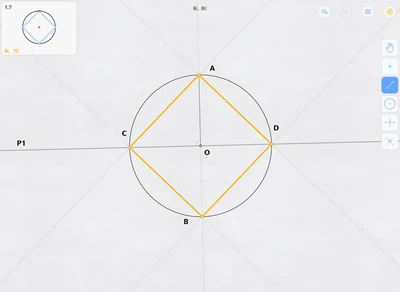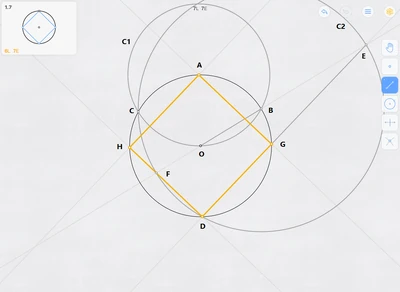Where there is matter, there is geometry. — Johannes Kepler
Solutions
Let O be the center of the circle and A the vertex.
6L Solution
- Construct line OA, intersecting the circle at point B.
- Construct the perpendicular bisector of AB, intersecting the circle at points C and D.
- Construct line AC.
- Construct line BC.
- Construct line BD.
- Construct line AD.
7E Solution
- Construct the circle with center A and radius OA, intersecting circle O at points B and C.
- Construct the circle with center B and radius BC, intersecting circle O at D.
- Construct line OB, intersecting circle B at points E and F.
- Construct line ED, intersecting circle O at point G.
- Construct line AG.
- Construct line DF, intersecting circle O at point H.
- Construct line AH.
Explanation
Solution 6L is easy as the inscribed square's center is the same as the circle's center, so you can find the vertex opposite to A as its diametrical opposite. That diameter is also a diagonal of the square, so by constructing its perpendicular bisector and second diagonal of the square, you can find the two remaining vertices and just need to trace the whole square.
Solution 7E is trickier. By construction, ABOC is a rhombus, and ABO and ACO are equilateral triangles as all their sides are equal. Therefore, AO and BC (the rhombus's diagonals) are perpendicular bisectors to each other, and angle BOC is 120°.
By construction as well, BCD is an isosceles triangle as BC=BD, and since angle ∠BDC is the inscribed angle that subtends the same arc as the central angle ∠BOC, ∠BDC=120°/2=60°. Therefore, BCD is also an equilateral triangle and AO is one of its bisectors and passes through D, making A, O and D collinear and A and D diametrical opposites on circle O.
Constructing line OB gives you EF, a diameter of circle B, and as such, EDF is a right triangle. And since AD is a diameter of circle O, AGD and AHD are right triangles as well. So, AGDH has three right angles and is therefore a rectangle. In fact, you can construct any diameter EF of circle B (that doesn't pass through point O) and similarly prove that the resulting AGDH is a rectangle.
Now, the fact that the diameter EF passes through point O allows you to determine several angles, for example angle ∠ADG.
∠ADG=∠ADB+∠BDG
∠ADB is known since the triangle BDC is equilateral and AD is one of its bisectors, so ∠ADB=60°/2=30°.
∠BDG=∠BEG since the triangle BED is isosceles. Also ∠BEG is the inscribed angle that subtends the same arc as the central angle ∠FBD in circle B, so ∠BEG=∠FBD/2. Also, in circle O, ∠FBD is the inscribed angle that subtends the same arc as the central angle ∠FOD, so ∠FBD=∠FOD/2. ∠FOD itself is known as it's the opposite angle of ∠AOB and is therefore 60° as AOB is equilateral. So ∠BDG=∠BEG=∠FBD/2=∠FOD/4=60°/4=15°
So ∠ADG=∠ADB+∠BDG=30°+15°=45°, which makes triangle AGD right and isosceles. Therefore, the two adjacent sides AG and GD of the rectangle AGDH are equal, which makes AGDH a square.

